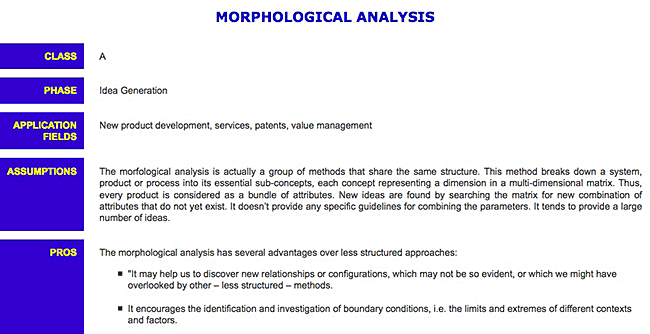Morphological Analysis
Background: Fritz Zwicky, the brilliant astrophysicist who discovered what we now call dark matter, devised his own method for systematically structuring and investigating the many possible relationships of complex problems.

Variations of his approach underlie many of the systems we use today to find the best new ideas, products, and solutions among a great variety of possibilities.
How to Use Morphological Analysis
Many problems challenge us with too many possible solutions, though yet uncovered, only some of which may be new and useful. This process, drains the swamp, so to speak, by systematically arranging appropriate and promising aspects of the situation and combining them just as systematically in order to identify new and suitable combinations.
The object is to break down the system, product, or process problem at hand into its essential parameters or dimensions and to place them in a multi-dimensional matrix. Then to find new ideas by searching the matrix for creative and useful combinations. Some combinations may already exist, others may not be possible or appropriate. The rest may represent prospective new ideas.
If you can describe a problem situation in terms of its aspects or dimentions, morphological analysis will uncover original and often innovative solutions.
Morphological Analysis Steps
1. Determine suitable problem characteristics. The individual problem solver or a facilitated group brainstorms to define problem characteristics, also refered to as parameters.
2. Make all the suggestions visible to everyone and group them in various ways until consensus is reached regarding the groupings.
3. Label the groups reduce them to manageable number. Rather than reaching for a recommended number, consider the capabilities of the group and the time available. Consider also that there are computer applications and other tools that can assist the process.
When working with the tangible aspects of something like a consumer product, for example, the labels gleaned from the groupings might include parameters such as product ingredients, color, textures, temperature, and flavor as well as package size, shape, function, and graphics. In the case of manufacturing issues, parameters might include material, function, process, construction, maintenance, and the like.
4. The next step is to fill a grid or grids with lists of parameters arranged along the axes. Now combinations can be identified within the grid. Depending on the number of items in play, great numbers of combinations may be available.
5. Eliminate those combinations that are impossible or undesirable to execute, put aside those that you do not want to eliminate but do not want to execute, and develop as many of the rest as possible.
The descriptions below offer a number of examples of parameter grids as examples.
More about Morphological Analysis
General Morphological Analysis
Wikipedia
Mycoted
